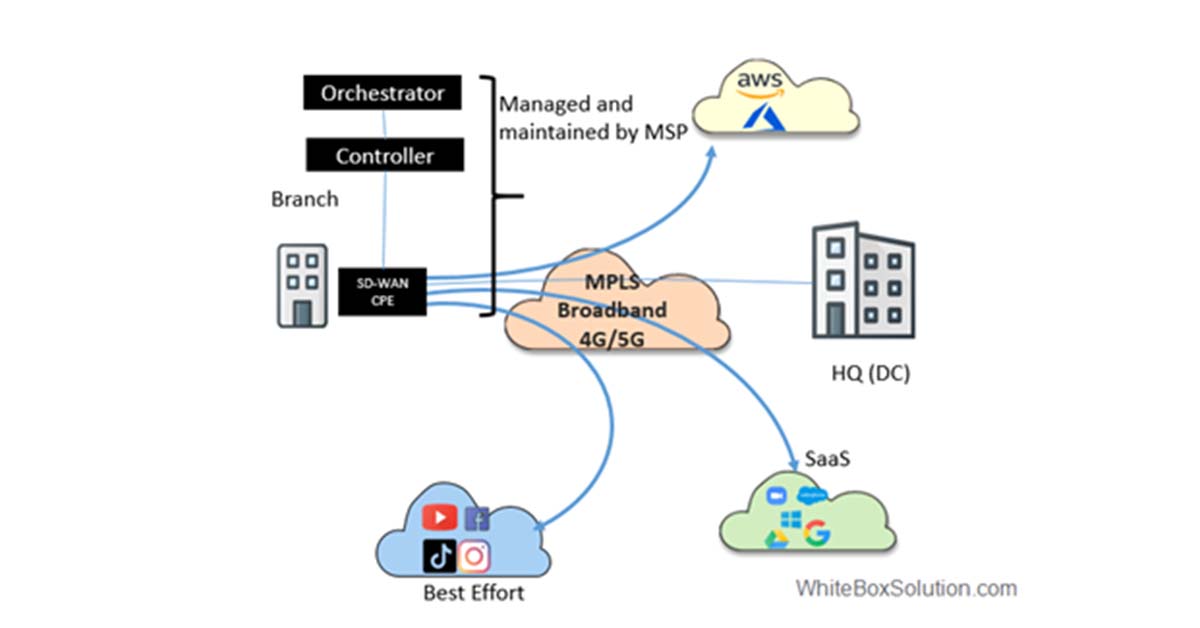So, you are looking to acquire an SD-WAN solution?
One of the first decisions you must make is to choose an approach: getting an SD-WAN system and managing it yourself (DIY) or letting a service provider manage it (Managed).
Both have their pros and cons.
Through this blog, we intend to define both models, give the pros and cons of both models, and then discuss which model may best fit your requirements.
Before that, a word about SD-WAN:
SD-WAN is an overlay technology that is transport agnostic and uses any combination of underlay transport such as MPLS, internet, LTE, and 5G to connect users with applications.
As applications move to SaaS and public clouds, SD-WAN offers the most efficient way to connect users with the applications. Also, more and more SD-WAN vendors have integrated their solutions with public cloud services such as AWS, Azure, and GCP, offering hosted services at a PoP near the users.
What is Managed SD-WAN?
A managed service provider (MSP) is the SD-WAN provider responsible for installing, managing, and maintaining the SD-WAN solution for an enterprise. The MSP will guarantee SLAs for SD-WAN service and provide 24/7 technical support for the SD-WAN solution.
 Fig: Managed SD-WAN Infrastructure
Fig: Managed SD-WAN Infrastructure
What is DIY SD-WAN?
An enterprise installs, manages, and maintains the SD-WAN solution itself. An enterprise will need a dedicated team responsible for maintaining and ensuring SLAs for the SD-WAN solution/services.
Why has Managed SD-WAN Service become popular?
As companies evolve in their journey to digital transformation, they need to evolve their technology. However, network infrastructure has become very complex today. However, enterprises are not used to SD-WAN technology. And SD-WAN solutions also support other functions besides SD-WAN.
For example, SD-WAN CPE can work as a universal CPE offering firewall, WAN optimization, IPS, and IDS. These services will then need a virtualization layer to manage different resources in the CPE. All this requires skillsets on the part of the enterprise that are not always available.
With limited IT budgets, maintaining an SD-WAN network seems challenging for some enterprises.
Therefore, an enterprise would ideally like to outsource SD-WAN management to a managed service provider to focus on its core business.
That is why the managed SD-WAN market is growing. Future market insights report has projected that the Managed SD-WAN Services market will reach around US$ 11.0 billion by 2031 with a growth rate of 30% over the 2021-2031 forecast period.
However, some enterprises still prefer the DIY approach for SD-WAN technology compared to the Managed model, so let us compare both.
Managed SD-WAN vs. DIY SD-WAN
The following table compares both types of SD-WAN side by side and shows the pros and cons of each.
| MANAGED SD-WAN | DIY SD-WAN | |
| AUTONOMY/ FLEXIBILITY | ● Enterprise has less Autonomy and less control on all aspects of the life cycle of service (Design, SD-WAN deployment, and Operation) | ● Enterprise has full Autonomy and complete control of all aspects of the life cycle of service (Design, SD-WAN deployment, and Operation) |
| AGILITY | ● Faster integration of new sites
● Faster Time to market ● Faster upgrades |
● Slower integration of new sites
● Slower Time to market ● Slower upgrades |
| OPERATION | ● Managed by the MSP so operationally easier for the enterprise as MSP takes care of the problems’ resolution and ongoing maintenance. | ● It needs a dedicated team and skillsets to maintain the network, which requires resources, that can contribute to OPEX costs. |
| REGULATORY COMPLIANCE | ● Some countries require strict compliance on how and where customers’ data resides. This kind of compliance is more challenging, especially if NOT all the data is kept locally by the MSP. | ● Enterprise has full control of all data aspects, making regulatory compliance easier.
|
| SCALABILITY | ● More scalable to add the resources on demand as the managed SD-WAN provider controls scalability | ● DIY SD-WAN solution requires proactive planning and is more challenging to expand in short time, thus reduced scalability |
It would be good also to mention a third model called “Co-managed SD-WAN” or “Hybrid SD-WAN.”
In the co-managed model/hybrid model, both the enterprise and service provider divide the responsibilities, with the service provider taking care of the technical support while the enterprise can do some of the configuration changes like setting application performance (to manage user experience) and security policies; depending on the contract, the enterprise can even provision new services. The key benefit is that the enterprise has more control over the SD-WAN platform/service than managed SD-WAN model.
Conclusion: Which one is better? Managed SD-WAN or DIY SD-WAN?
There is no clear winner, but it depends on each enterprise’s situation. Managed SD-WAN may be a default approach for any enterprises that would like to outsource the management of SD-WAN as they do not have sufficient technology skillsets/staff related to SD-WAN or sufficient IT budgets for ongoing maintenance of the system. A DIY approach may seem more appropriate for larger organizations with enough IT budget, support teams, or government organizations that want complete control and visibility of their network.
About Lanner’s SD-WAN solutions:
Lanner is a front-runner in producing vCPE/UPE and white box platforms for purposes such as SD-WAN, NFV, SDN, Edge computing, and Open RAN. It has a presence in the US through its subsidiary, Whitebox Solutions (www.whiteboxsolution.com).
Lanner is agnostic to managed SD-WAN or DIY SD-WAN approach as its white box works in either setup.
It offers pre-integrated vCPEs and uCPEs devices with different SD-WAN and VNF software providers. These customized solutions are suitable for all types of organizations, from smaller branch offices to larger data centers, both desktop, and rack-mounted models.
You can visit Lanner’s SD-WAN solutions at
https://www.lannerinc.com/applications/sd-wan/pre-validated-ucpe-platforms-accelerating-your-sd-wan-deployment








